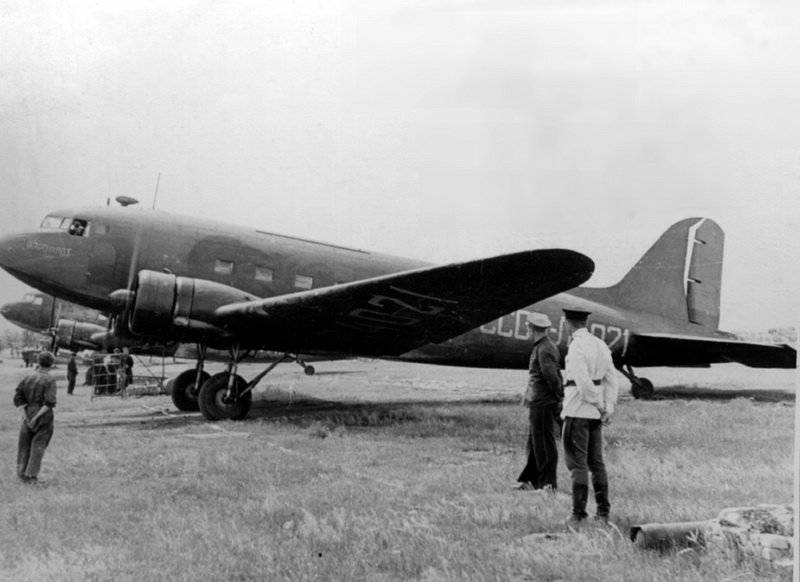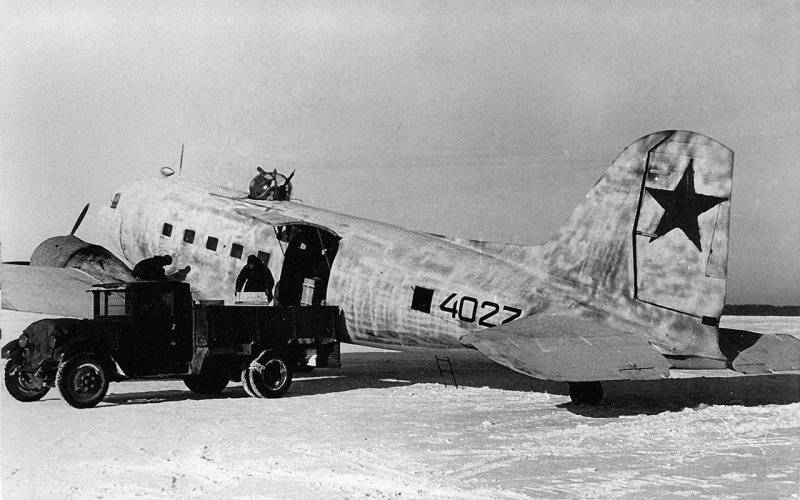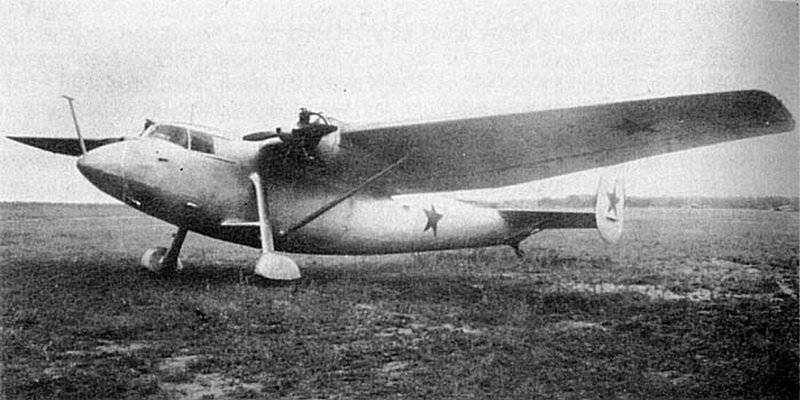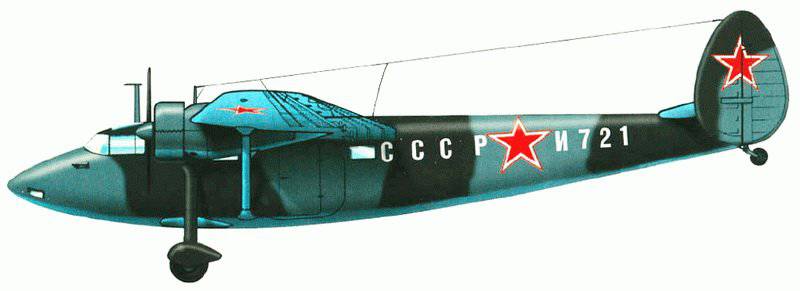Aviation of the Red Army of the Great Patriotic War (part of 4) - Li-2 and Sche-2 transport aircraft
In parallel with the acquisition of the DC-3 aircraft, the USSR also bought a license for the assembly of its modification DC-3-196, which was mastered at the plant number 84. V.P. Chkalov in Khimki near Moscow, the plane received the name PS-84 (Passenger aircraft of plant number 84). Beginning in the middle of 1938, domestic enterprises began the introduction and mass production of this aircraft. Since September 1942, he acquired his second name Li-2, after the name of the plant’s chief engineer Boris Pavlovich Lisunov, who led the project for its implementation.
Li-2 military transport aircraft
In April 1941, the Khimki plant launched its 100th PS-84 aircraft; by the beginning of World War II, Aeroflot had 72 PS-84 aircraft at its disposal, another 49 were registered in the Air Force, and 5 were on navy. Initially, the crew of the passenger version of the car consisted of 5 people: 2 pilots, a flight mechanic, a flight attendant and a flight attendant, who was called a barmaid. Immediately after the outbreak of war, all PS-84s were assembled into special air units of the Civil Air Fleet, which were engaged in supporting combat operations. As of June 25, there were already 68 PS-84 and DC-3 in them. Since the beginning of the war, the plant for the production of these aircraft was evacuated to Tashkent, where after 1 month it restored production of aircraft by 30%, releasing mainly its military transport version. Since July 1941, all the Douglas began to receive defensive weapons. In total, over the years of the war, the Tashkent aircraft plant produced 2258 Li-2 aircraft.

The design of the aircraft was all-metal with linen covering ailerons and rudders. When adapting its production, a rather difficult task was successfully solved - recalculation of all sizes and thicknesses of materials used in metric measures, with careful recalculation of all structural elements according to Soviet strength standards, leading to state standards. After carrying out this work, the mass of the aircraft slightly increased, but security was improved. V.Myasischev supervised the conversion of dimensions from inches to millimeters and the processing of drawings for domestic technology. The civilian version of the aircraft had a 21 passenger seat. When adapting, the passenger compartment and the cabin were slightly repackaged, depreciation struts designed for heavy loads were designed, the wheels were replaced with domestic ones.
The power plant of the aircraft included the X-NUMX of the M-2IR engine, which had an 62 hp take-off power. each. The maximum power of the motors at the height of 1000 m. Was 1500 HP. This engine could be called the "cousin" of the American Wright Cyclone SGR-840-G1820 motor. Both of these engines were the product of improvement of the original SR-2-F1820, which was produced by the domestic industry under the brand M-3. The aircraft used screws variable pitch type VISH-25.
The defensive armament of the aircraft consisted of 4 XKAS machine guns, one of them was mounted motionless in the nose fairing in front of the cockpit, one in the turret turret (later replaced with XBNUMX UBT machine gun) and one installations in the side hatches of the aircraft. Servicing the upper machine-gun installation was engaged in side shooters, pivot machine guns were serviced by a radio operator and a flight engineer who, in the event of an air threat, passed into the tail of the aircraft. From the machine gun course, the fire was fired by the captain himself. Installed weapons "eaten" at different heights to 12,7-14 km / h from the maximum speed with equal take-off weight. Also, the flight range fell to 17 km. and rate of climb deteriorated - to a height of 2350 km. the car got on the 5 minutes longer. Binding and steel armored seats of the crew.

During the war, the aircraft was often used for different tasks - delivery of all kinds of cargo to the partisans (loading up to 2 000 kg.), Regular flights for transportation l / s, parachute landing. These aircraft knew and loved in the army, all of them without exception were called "Douglas". If necessary, the transport aircraft easily turned into a landing ship; for this purpose, in its cargo compartment, seats for the 25-27 paratroopers were put in full winter gear and with weapons. In the transport version, the seats simply folded to the sides of the fuselage and were fixed with belts. Boarding an assault aircraft through the 1 door took 80 with., Through both - 25-30 with. For the forced disclosure of parachutes in the plane there were special hooks in the cabin.
It was not difficult to convert the aircraft into a sanitary version; for these purposes, the flight mechanic had enough 10 minutes. In this case, 3 stretchers were installed in the cargo compartment in the 18 tier - 9 from each side. Six stretchers from the first tier were located directly on the floor and fastened on it with leather straps. Stretchers of the second tier were mounted on collapsible brackets, and the third with folding brackets and hangers mounted on the ceiling. In addition, 2 lightly wounded and 1 health worker could also be accommodated on folding seats.
Since the summer of 1942, the bomber version of the aircraft was also produced. In this case, the holders were installed on the 1000 kg under the center section. bombs, the maximum fuel supply increased to 3 100 liters, and the take-off weight of the aircraft reached 11 500 kg, at the pre-war rate in 10 900 kg. The load in 1 ton of bombs provided the maximum range, working on a "short arm" the plane could take significantly more bombs, but there was nowhere to hang them. In such cases, the crews often took small bombs directly into the fuselage, from where they dropped them through the door with their hands. The main bomb racks of the aircraft were equipped with regular electric bomb emitters, as well as emergency mechanical ones. Aiming was carried out using a primitive reticle, which was installed at the right window of the cabin. To look at it, you had to stick your head out the window.

Li-2 performance characteristics:
Sizes: wingspan - 19,66 m., Length - 29,98 m., Tail height - 5,17 m.
Wing area - 91,7 square. m
Aircraft takeoff weight - 10 900 kg.
Engine type - 2 M-62IR, power of each 1000 hp
The maximum speed is 320 km / h.
Practical range: 2500 km.
Practical ceiling: 5 600 m.
Crew - 4 person.
Payload: up to 27 paratroopers or 18 stretcher or up to 2000 kg. cargo.
Scho-2 transport aircraft
By the beginning of World War II, the basis of transport aviation The air forces of the Red Army were airplanes TB-3 (G-2), as well as light multipurpose U-2 (Po-2). At the same time, these aircraft differed by an order of magnitude in their carrying capacity - the TB-3 could carry from 2 to 000 kg of cargo, while the U-4 did not exceed 000 kg. At the same time, a light and economical aircraft that could be used to transport medium-weight cargo (up to 2 kg) simply did not exist. That is why there was a need for the design of a medium-duty aircraft, which would serve parts of the army.
A group of engineers headed by Alexey Yakovlevich Shcherbakov took up the solution of the problem on their own initiative. In 1941, Shcherbakov was the director and at the same time the chief designer of the aircraft repair plant, which not only repaired the aircraft, but also launched production of special wing containers for the transport of small loads, which were installed on the P-5 and U-2 aircraft, as well as fighter planes. Prior to that, Shcherbakov worked for many years in the design bureau, it was he who was the first in the USSR to create airtight cabins that were tested on serial machines I-15, I-15bis, I-153, La-5, MiG-1, Yak-7B, and also a large a series of experimental machines.

In 1941, A. Ya. Shcherbakov proposed the creation of a special transport aircraft that would be designed for transporting medium loads. Initially, only marine aviation showed interest in such a project. In the autumn of 1941, the development of the aircraft began, and in early February of 1942, the first prototype of the transport aircraft took off. The aircraft received the designation TC-1, which meant the transport aircraft - the first.
The TC-1 was a strut-down monoplane, the design of which was mainly wooden. The wing layout was top. The aircraft had two-tail and two-wheel non-retractable landing gear. On the prototype were 2 engine M-11 with power 115 hp The TS-1 was designed to transport any aircraft engines (star and in-line), wings, aircraft assemblies and other military equipment, small anti-tank guns, as well as other oversized cargo weighing up to 1 tons. At the same time, the aircraft could land at sites of limited sizes. This type of transportation was very important in the conditions of warfare, when urgent repairs of combat aircraft had to be carried out directly at the airfields in the field.
In August 1943, the flight tests of the new aircraft were completed, and the People's Commissariat of the aircraft industry recommended it for mass production under the designation Sche-2. The launch began in October, and the head machine of the series was ready for the 1944 summer of the year, 567 copies of the aircraft were built. The Shche-2 transporter was accessible and easy to operate, even for mid-skilled personnel. The power of two engines 115 HP It was clearly not enough to transport a ton of 1 cargo. In essence, the Sche-2 was a motor glider with unrealized capabilities of a full-fledged aircraft. Situations could correct aircraft engines with a capacity of 150-200 hp, but such engines were not mass-produced in the USSR.

Frontline pilots reacted negatively to this car. The Pro-2, which had a distinctive appearance, even came up with an ingenious mystery: “The nose of the Li-2, the tail of the Pe-2, the motors of the U-2, flies barely”. In spite of this, the Szcze-2 was very economical and could, through a large door in the port side, take up to 1 tons of payload. Most often it was used for the tasks of promptly providing all the necessary spare parts and components repaired at the airfields of aircraft. Depending on the situation and the tasks assigned, the XE-2 was used as a cargo (1 000 kg), transport (up to 16 people), sanitary (up to 9 stretcher). Also, the machine was used to train crews of bombers and training paratroopers (up to 9 paratroopers).
Performance characteristics of Sche-2:
Dimensions: wingspan - 20,48 m., Length - 14,27 m., Height - 3,8 m.
Wing area - 63,9 square. m
Aircraft takeoff weight - 3 400 kg.
Engine type - 2 M-11D, power of each 115 hp
The maximum speed is 160 km / h.
Practical range: 850 km.
Practical ceiling: 2 400 m.
Crew - 2 person.
Payload: up to 16 man or 9 paratroopers or 9 stretcher or 1000 kg. cargo.
Information sources:
-http: //www.airpages.ru/ru/li2.shtml
-http: //www.airwar.ru/enc/cww2/li2.html
-http: //www.luxavia.ru/item/105
-http: //ru.wikipedia.org
This film tells about the training, transport and multipurpose aircraft of the USSR of the thirties and forties. You will learn about the P-5 scout, the Ut-2 training aircraft, the Li-2 transports and the B-2 bombers, as well as the simplest and safest, but terrified, Wehrmacht soldiers, the multipurpose U-2 aircraft (Po-XNX ).
Information